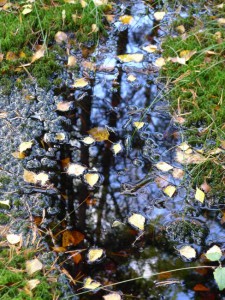
Birch tree leaves resting on the surface of a small amber-coloured pond that has formed after the rain. Photo: Lasse Johansson
In the autumn, leaves fall onto the ground, into the small ponds forming here and there, soon with brownish amber-coloured water. Resting for a moment on the surface, until a splash or a footstep causes it to cross the surface and sink towards the bottom, contributing to the forming colour.
As the leaves break down, the oxygen in the water is consumed, and the humus acids tint the pond. The water in the lower layers becomes reductive, oxygen deficit. Slowly the water sinks down, and enters the groundwater cycle.
What could these two things, the resting leaf and the amber-coloured water tell us about water quality?
What is actually water quality? We tend to define it as absence of things: absence of suspended particles, absence of harmful or ill-tasting substances, absence of pathogenic organisms. A processed drinking water, saturated with oxygen and filtered through sand beds, constitutes what many of us drink. But is this quality? How would we indeed measure the quality of water? If water has quality, should it contribute to our health (any more than just not being a direct hazard to us)?
On reflection, the answer seems to be in the affirmative. So the ultimate measure of the quality of the water would be to measure how it contributes to our health. Surely, in the end we will have to resort to measuring properties in water, to find out exactly what it is in a water sample that contributes to our health. But that cannot be the ultimate measure, merely our way to predict health, to predict the water’s effect on our health. We tend to forget that, tend to think that our models are complete; that the map describes all there is to know of reality.
But shouldn’t we try to measure the quality of water? One who tried was the French hydrologist Louis-Claude Vincent (1906-1988). When he studied the spread of flu in France, he observed that during epidemics some regions were completely passed over. Investigating this further he found that the drinking water in regions with better health figures was different: it was more reductive – that is, it would contain substances that would tend to react with oxygen and consume it, and as a consequence contained less dissolved oxygen.
This reductive water, he argued, would create a biological environment in the body (he coined the term “bio-logical terrain”), less conductive to being affected by illness and disease. Remembering that what the hydrologist calls a reductive substance, in medicine is called an anti-oxidant, one realizes that it may not be so mystical after all, as anti-oxidants are known to be related to health effects.
Routinely our drinking water is aerated to rid it of iron and other reductive substances that taste less well. But do we not then destroy some of the conditions in the drinking water that would be conductive to good health?
Read more
Based on studies of municipal waters from 1926 an onwards, Louis-Claude Vincent developed in 1948 a characterization of potable waters using three electrochemical parameters: pH, redox (rH) and resistivity. (Instead of resistivity its inverse, conductivity, is often used as a measure, as it correlates more to dissolved inorganic solids in the water).
He found that municipal drinking waters in regions with lower mortality and good public health figures in France were reductive, slightly acidic and had low conductivity (but not too low). Perfect drinking waters were later classified as having pH: 5.5-7.0, rH: 24-28 (rH less than 28 is reductive), and conductivity 10-170 uS. These kinds of natural waters are typically found in areas with granitic and acid volcanic rocks.
Factors affecting health negatively according to Vincent were: too much dissolved solids in the water (low resistivity, i.e. high conductivity) and alkaline and oxidative waters resulting from water treatment (e.g. chlorination) – i.e. many municipal drinking waters.
In a sampling of natural and municipal waters in Sweden performed in 2003-2005, I observed that many traditional healing springs and sacred springs in Sweden would be reductive and be slightly acidic or neutral, whereas most of the municipal drinking waters studied would be oxidative (rH: 29.5-31) and alkaline (pH: 7.5-8.5).
Traditional acid wells (iron wells) – which had a widespread therapeutic use from the late 17:th century up until the early 20:th century – are typically even more reductive (rH: 16-22), but often contain more dissolved minerals (higher conductivity).
The results are summarized in the following report, with a discussion on redox and alternative ways to measure water quality. It also contains a database of some Swedish municipal and spring waters (including some very reductive waters). See particularly chapters 5.2-5-6, 6.3, and the database in Appendix A (A.1 & A.2):
-
Johansson L. Alternativ vattenbehandling – Effekter, mekanismer och perspektiv på vattenkvalitet Institute of Ecological Technology, Scientific & Technical Reports, No. 2, Gothenburg, 2005, ISBN 91-975722-1-7 (downloadable)


